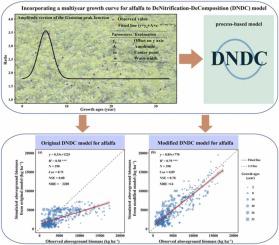Field Crops Research ( IF 5.6 ) Pub Date : 2023-05-08 , DOI: 10.1016/j.fcr.2023.108966 Rongzhu Qin , Jia Xu , Matthew Tom Harrison , Ke Liu , Feng-Min Li , Guojun Sun , Feng Zhang

|
Context
Reliable, rapid and timely assessments of forage crop biomass are crucial for managing feed supply and animal husbandry. While process-based models are regularly promulgated in modeling crop and pasture growth and development, the reliability and functionality of such models in simulating alfalfa (Medicago sativa L.) growth remains limited.
Objective
The purpose of this study was to address deficits associated with simulation of long-term growth dynamics in perennial alfalfa; to assess potential alfalfa yield across the Loess Plateau and dissect key abiotic factors constraining alfalfa yields.
Methods
We undertook an extensive review of the literature to collate and analyze existing alfalfa biomass data across the entire Loess Plateau in China. We then developed an alfalfa multi-year growth curve using a Gauss-amplitude function; when enacted this algorithm reliably reproduced the rise, peaks and declines in biomass with crop development. To assess the performance of our new function as part of an integrated system, we incorporated a multi-year growth curve into the DeNitrification-DeComposition (DNDC) model to assess longitudinal yields under rain-fed and irrigation conditions.
Results and conclusions
Our adapted model reproduced aboveground trends in biomass more accurately than the original model. The regional simulation results show that alfalfa yield was less than 8000 kg ha–1 in most areas with an annual precipitation lower than 500 mm under rain-fed condition, while the alfalfa yield in most areas was above 8000 kg ha–1 under irrigation condition. Compared with rain-fed alfalfa, there is an increased 69% of yield after irrigation in irrigated areas of the Loess Plateau. The rain-fed alfalfa yield was severely constrained by drought when the aridity index fell below 0.31.
Significance
Our new model development paves the way for additional refinement of alfalfa crops in process-based models, and provides opportunities for adoption of alfalfa crops in new regions by adjusting the parameters in the Gauss-amplitude function.











































 京公网安备 11010802027423号
京公网安备 11010802027423号